|
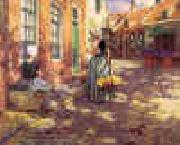 |
George Hitchcock
|
|
1850-1913
George Hitchcock (1850 - 1913), American artist, was born in Providence, Rhode Island.
Hitchcock graduated from the University of Manitoba, and from Harvard Law School in 1874. He then turned his attention to art and became a pupil of Gustave Boulanger and Jules-Joseph Lefebvre in Paris.
He attracted notice in the Paris Salon of 1885 with his "Tulip Growing", of a Dutch garden he painted in the Netherlands. For years he had a studio at Egmond-aan-Zee, in the Netherlands. He became a ch??valier of the French Legion of Honour; a member of the Vienna Academy of Arts, the Munich Secession Society, and other art bodies; and is represented in the Dresden gallery; the imperial collection in Vienna; the Chicago Art Institute, and the Detroit Institute of Arts. |
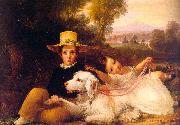 |
George Henry Harlow
|
|
British
1787-1819
He was born in St. James's Street, London, on 10 June 1787, the posthumous son of a China merchant, who after some years' residence in the East had died about five months before his son's birth, leaving a widow with five infant daughters. Indulged and petted by his mother, Harlow was sent when quite young to Dr. Barrow's classical school in Soho Square, and subsequently to Mr. Roy's school in Burlington Street. He was for a short time at Westminster School, but having shown a predilection for painting, he was placed under Henry De Cort, the landscape-painter. He next worked under Samuel Drummond, A.R.A., the portrait-painter, but after about a year entered the studio of Sir Thomas Lawrence, P.R.A. This step is said to have been taken at the suggestion of Georgiana, duchess of Devonshire; but Harlow's natural affinity to Lawrence's style in painting would be quite sufficient to account for his choice. Harlow paid Lawrence handsomely for his admission and the right to copy, but according to the contract was not entitled to instruction.
Harlow now determined to devote himself to painting, and refused an offer of a writership in the East India trade made by his father's friends. He remained for about eighteen months in Lawrence's studio, copying his pictures, and occasionally drawing preliminary portions of Lawrence's own productions. A difference about Harlow's work for one of Lawrence's pictures led to a breach with Lawrence, and Harlow rendered reconciliation impossible by painting a caricature signboard for an inn at Epsom in Lawrence's style and with Lawrence's initials affixed to it.
Harlow henceforth pursued an original system of art education. He inveighed strongly against all academical rules and principles. Young, headstrong, and impatient of restraint, with a handsome person and amiable disposition, he was generally popular in society. He affected, however, an extravagance in dress far beyond his means, a superiority of knowledge, and a license of conversation which gave frequent offence even to those really interested in the development of his genius. His foibles led his friends to nickname him "Clarissa Harlowe." He worked, however, with industry and enthusiasm in his art. He possessed a power of rapid observation and a retentive memory which enabled him to perform astonishing feats, like that of painting a satisfactory portrait of a gentleman named Hare, lately dead, whom Harlow had only once met in the street. Though openly opposed to the Royal Academy, he was a candidate for the dignity of academician, but he only received the vote of Henry Fuseli.
He exhibited for the first time at the Academy in 1804, sending a portrait of Dr. Thornton. In later years he exhibited many other portraits. His practice in this line was extensive. His portraits are well conceived, and, though much in the manner and style of Lawrence, have a character of their own. His portraits of ladies were always graceful and pleasing. He was less successful, owing to his defective art-education, in historical painting, in which he aspired to excel. His first exhibited historical pictures were Queen Elizabeth striking the Earl of Essex, at the Royal Academy, 1807, and The Earl of Bolingbroke entering London, at the British Institution, 1808.
In 1815 he painted Hubert and Prince Arthur for Mr. Leader, a picture subsequently exchanged for portraits of that gentleman's daughters. In 1814 he painted a group of portraits of Charles Mathews, the actor, in various characters, which attracted general attention. It was engraved by W. Greatbach for Yate's Life of Mathews. Harlow received a commission from Mr. Welch, the musician, to paint a portrait of Mrs. Siddons as Queen Katharine in Shakespeare's Henry VIII. This was commenced from memory, but subsequently the actress, at Mr. Welch's request, gave the painter a sitting. While painting the portrait, Harlow resolved to expand the picture into the "Trial Scene" from the same play, introducing portraits of the various members of the Kemble family and others. Mr. Welch, though not consulted by Harlow concerning this change of plan, behaved generously. The picture was exhibited at the Royal Academy in 1817, and excited great public interest. It was neither well composed nor well executed, and owed much to the criticism and suggestions of Fuseli, whose portrait Harlow was painting at the time. Still, the portrait of Mrs. Siddons herself as the queen will remain one of the most striking figures in English art. The fine engraving of it in mezzotint hy George Clint has enhanced its reputation. The picture passed eventually into the possession of Mr. Morrison at Basildon Park, Berkshire. It was exhibited at Manchester in 1857.
Harlow's next picture, The Virtue of Faith, at the Royal Academy, lacked originality, and had less success. It was purchased by his friend Mr. Tomkisson, who divided it into pieces for the sake of the heads.
In 1818 Harlow, conscious of deficiencies in his executive powers, visited Italy for the purpose of studying the old masters. At Rome his personal gifts and accomplishments, and his remarkable powers of execution, made him the hero of the day. He was f??ted and flattered in every direction. Canova was especially attracted by him, and obtained for him an introduction to the pope. Harlow, however, worked very hard, and completed a copy of Raphael's Transfiguration in eighteen days. He was elected a member for merit of the Academy of St. Luke at Rome, a most unusual distinction for an English artist, and was invited to paint his own portrait for the Uffizi gallery of painters at Florence. He painted a picture of Wolsey receiving the Cardinal's Hat in Westminster Abbey, and presented it to the Academy at Rome.
His artistic progress in Italy was remarkable, but on his return to England on 13 Jan. 1819 he was seized with a glandular affection of the throat, which being neglected proved fatal on 4 Feb. He was in his thirty-second year. He was buried under the altar of St. James's, Piccadilly, and his funeral was attended by the eminent artists of the day. An exhibition of his principal works was held in Pall Mall. His collections, including many sketches, were sold by auction 21 June 1819.
Harlow is one of the most attractive figures in the history of English painting. His works only suggest what lie might have achieved. Many of his portraits have been engraved, and those of James Northcote, Fuseli, Thomas Stothard, William Beechey, John Flaxman, and others are highly esteemed. His own portrait, painted by himself for the gallery at Florence, was engraved for Ranalli's Imperiale e Reale Galleria di Firenze. A drawing from it by J. Jackson, R.A., was bequeathed to the trustees of the National Portrait Gallery in 1888 by the painter's nephew, G. Harlow White. Another drawing by himself was engraved by B. Holl for the Library of the Fine Arts. His own portrait is introduced in the background in the picture of The Trial of Queen Katharine. A portrait of the Prince of Wales (afterwards George IV) by Harlow was engraved in mezzotint by W. Ward.
|
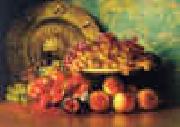 |
George Henry Hall
|
|
1825-1913
American painter. Brought up in Boston, he began his career as an artist at the age of 16. In 1849 he travelled with his friend Eastman Johnson to D?sseldorf. Hall studied at the K?nigliche Akademie for about a year, and after a further two years of study in Paris and Rome he returned in 1852 to New York where he settled. However, he remained an enthusiastic traveller and spent a total of more than 20 years abroad. |
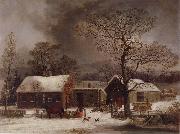 |
George Henry Durrie
|
|
American Painter, 1820-1863,American painter. Durrie and his older brother John (1818-98) studied sporadically from 1839 to 1841 with the portrait painter Nathaniel Jocelyn. From 1840 to 1842 he was an itinerant painter in Connecticut and New Jersey, finally settling permanently in New Haven. He produced c. 300 paintings, of which the earliest were portraits (e.g. Self-portrait, 1839; Shelburne, VT, Mus.); by the early 1850s he had begun to paint the rural genre scenes and winter landscapes of New England that are considered his finest achievement. His landscapes, for example A Christmas Party (1852; Tulsa, OK, Gilcrease Inst. Amer. Hist. & A.), are characterized by the use of pale though cheerful colours and by the repeated use of certain motifs: an isolated farmhouse, a road placed diagonally leading the eye into the composition, and a hill (usually the West or East Rocks, New Haven) in the distance. By the late 1850s Durrie's reputation had started to grow, and he was exhibiting at prestigious institutions, such as the National Academy of Design. In 1861 the firm of Currier & Ives helped popularize his work by publishing prints of two of his winter landscapes, |
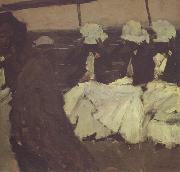 |
George Hendrik Breitner
|
|
Dutch Painter, 1857-1923
Dutch painter and photographer. He trained as a painter and draughtsman at the academy in The Hague. Although the Dutch painter Charles Rochussen taught the students history and landscape painting, Breitner's interests did not lie in this area. In 1880 he worked for a year in the studio of Willem Maris after his academy training. Maris belonged to the Hague school of painters, who worked in the plein-air tradition of the French Barbizon school. Breitner painted outdoor life with them, although it was not the picturesqueness of the landscape or the Dutch skies that appealed to him. With Van Gogh he roamed the working-class districts of The Hague and through the dockyards of Rotterdam. Both artists recorded the vitality of city life in their sketchbooks. Breitner consciously chose these themes and motifs: he wanted to paint people going about their daily lives |
 |
George Hayter
|
|
1792 - 1871
English painter and printmaker. He was the son of Charles Hayter (1761-1835), miniature painter, author of manuals for art instruction and Professor of Perspective and Drawing to Princess Charlotte. In 1808 George entered the Royal Academy Schools, and in 1815 was appointed Painter of Miniatures and Portraits by Princess Charlotte. Hayter was awarded the British Institution's premium for history painting for the Prophet Ezra (1815; Downton Castle, Heref. & Worcs), purchased by Richard Payne Knight. Encouraged by his patron, John Russell, 6th Duke of Bedford, he travelled to Italy to study in 1816, gaining election as an honorary member of the Accademia di S Luca in Florence. Returning to London in 1818, Hayter practised as a portrait painter in oils and history painter and occasionally acted as an art dealer. Dubbed 'The Phoenix' by William Beckford, Hayter showed a pomposity that irritated his fellow artists, but he mixed freely with many aristocratic families. |
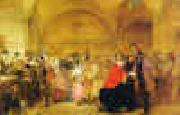 |
George Elgar Hicks
|
|
1824-1914
British
George Elgar Hicks Gallery
Born on March 13, 1824 in Lymington, Hampshire, George Elgar Hicks was the second son of a wealthy magistrate. His parents encouraged Hicks to become a doctor and so Hicks studied medicine at University College from 1840-42. However, after three years "ardous and disagreeable study" Hicks decided he wanted to be an artist. Due to this, Hicks began training as an artist considerably later in life than most artists of the time. In 1843, Hicks attended Sass's Academy and by 1844 had entered the Royal Academy Schools.
In 1847 Hicks married Maria Hariss and six of their eight children were born in the seven years following. He did not achieve much success as an artist during this period and later referred to his art at this time as "small and unimportant." He blamed this on the fact he had little time to study art or interact with other artists, due to his busy family life.
In 1859, Hicks painted his first large genre painting, Dividend Day. Bank of England (exhibited at the Royal Academy in 1859) following the success of Frith's paintings Ramsgate Sands and Derby Day at the Royal Academy. It was a typical genre painting, showing a scene from the Bank of England and featuring a broad range of social classes. Hicks painted several more large modern life paintings in the following years which were generally poorly reviewed by critics. These include The General Post Office. One minute to 6 (1860), Billingsgate Fish Market (1861) and Changing Homes (1862). Hicks paintings were often of subjects that no other artists attempted, such as the General Post Office and Billingsgate Fish Market. Hicks was one of the few artists that showed lasting interest in the emulation of Frith's style and is generally considered Frith's principal imitator.
By the late 1860s, the popularity of genre painting had waivered and Hicks began to focus on painting historical subjects, leading to society portraiture in the 1870s.
In 1884, Hicks remarried following the death of Maria in 1881. He retired in the 1890s and died a month before the declaration of World War I in 1914. |
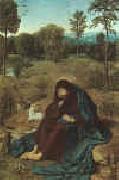 |
Geertgen Tot Sint Jans
|
|
Netherlandish Northern Renaissance Painter, ca.1460-1490
Geertgen tot Sint Jans is also known as Geertgen van Haarlem, Gerrit van Haarlem, or Gerrit Gerritsz.[citation needed] Alternative spellings of his first name are Gheertgen, Geerrit, and Gheerrit, where G(h)eertgen is the diminutive form of G(h)eerrit.
Presumably, he was born in Leiden, then in the Burgundian Netherlands in the Holy Roman Empire, around the year 1465. The assignment of Leiden as his birth place is traceable to a 17th century print by Jacob van Matham. There is no known archival evidence for this claim by Jacob van Matham. The modern acceptance of Leiden as Geertgen's birth place is roughly traceable to Johann Kessler's dissertation of 1930.
Probably, Geertgen was a pupil of Albert van Ouwater, who was one of the first oil painters in the northern Low Countries. Both painters lived in the city of Haarlem. Geertgen was attached to the monastery of the Knights of Saint John, for whom he painted an altarpiece. Although Geertgen was not a member of the Order of Saint John, his last name "tot Sint Jans" was derived from the order's name and means "unto Saint John".
Geertgen died in Haarlem, then the Habsburg Netherlands in the Holy Roman Empire, around the year 1495, when he was approximately 28 years old. He was buried in the monastery of the Knights of Saint John. Modern scholars have attempted to calculate the artist's death date with the information from The Painting-Book (Middle Dutch: Het Schilder-Boeck) by Karel van Mander, published in 1604. There are some archival traces that suggest he may in fact have lived into the 16th century. |
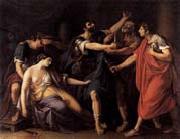 |
Gavin Hamilton
|
|
Scottish Neoclassical Painter, 1723-1798,Scottish painter, archaeologist and dealer, active in Italy. He was educated at Glasgow University and in 1748 arrived in Rome to study portrait painting under Agostino Masucci. He lodged with the architects James Stuart and Nicholas Revett; they probably encouraged him to visit Herculaneum and the recently discovered archaeological site of Pompeii, which had a profound effect on his subsequent career. Convinced that 'the ancients have surpassed the moderns, both in painting and sculpture', Hamilton undertook a systematic study of Classical antiquities during the 1750s and 1760s. In 1751 he was briefly in Scotland, where he painted a full-length portrait of Elizabeth Gunning, Duchess of Hamilton (Lennoxlove, Lothian), in a conventional style derived from van Dyck. He returned to Rome in 1752 and remained there, with the exception of short visits to England, for the rest of his life. In 1755 he was introduced by Anton Raphael Mengs to Johann Joachim Winckelmann, who was to become one of the leading theorists of Neo-classicism. In the same year Hamilton entertained Robert Adam, who studied in Rome from 1755 to 1757. He was to know and encourage almost all the British artists who worked in Rome during the second half of the 18th century. Henry Fuseli, who was not an uncritical admirer, wrote of Hamilton in 1805, |
 |
Friedrich Herlin
|
|
(c. 1425/30 - 1500) was a German painter. His earliest known work, depicting scenes from the Life of the Virgin, is dated 1459. A signature on an altarpiece in Nördlingen, dating it to 1462, identifies him as being from Rothenburg, as do citizenship documents from 1467. Nevertheless, it is possible that he lived there for only a short time, and that his origins lie in Ulm, where a painter named Hans Herlin lived and worked from 1449 until 1468. Stylistically, he borrowed much from Rogier van der Weyden, indicating a great deal of familiarity with the art of the Netherlands and of Cologne. The sculpture attached to the altarpiece of 1462, though officially listed as by the so-called "Master of Nördlingen", has been tentatively ascribed to Nicolaus Gerhaert, which if true would indicate extensive contacts to the highest artistic circles of the era.
Little else is known of Herlin, save that he died in Nördlingen in 1500.
|
 |
Friedrich Hagedorn
|
|
(23 April 1708 - 28 October 1754), German poet, was born at Hamburg, where his father, a man of scientific and literary taste, was Danish minister.
He was educated at the gymnasium of Hamburg, and later (1726) became a student of law at Jena. Returning to Hamburg in 1729, he obtained the appointment of unpaid private secretary to the Danish ambassador in London, where he lived till 1731. Hagedorn's return to Hamburg was followed by a period of great poverty and hardship, but in 1733 he was appointed secretary to the so-called "English Court" (Englischer Hof) in Hamburg, a trading company founded in the 13th century. He shortly afterwards married, and from this time had sufficient leisure to pursue his literary occupations till his death.
Hagedorn is the first German poet who bears unmistakable testimony to the nation's recovery from the devastation wrought by the Thirty Years' War. He is eminently a social poet. His light and graceful love-songs and anacreontics, with their undisguised joie de vivre, introduced a new note into the German lyric; his fables and tales in verse are hardly inferior in form and in delicate persiflage to those of his master La Fontaine, and his moralizing poetry re-echoes the philosophy of Horace. He exerted a dominant influence on the German lyric until late in the 18th century.
The first collection of Hagedorn's poems was published at Hamburg shortly after his return from Jena in 1729, under the title Versuch einiger Gedichte (reprinted by A. Sauer, Heilbronn, 1883). In 1738 appeared Versuch in poetischen Fabeln und Erzählungen; in 1742 a collection of his lyric poems, under the title Sammlung neuer Oden und Lieder; and his Moralische Gedichte in 1750. A collection of his entire works was published at Hamburg in 1757 after his death. The best is J.J. Eschenburg's edition (5 vols., Hamburg, 1800). Selections of his poetry with an excellent introduction in F. Muncker's Anakreontiker und preussisch-patriotische Lyriker (Stuttgart, 1894). See also H. Schuster, F. von Hagedorn und seine Bedeutung fer die deutsche Literatur (Leipzig, 1882); W. Eigenbrodt, Hagedorn und die Erzählung in Reimversen (Berlin, 1884).
|
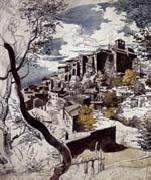 |
Franz Horny
|
|
German, 1798-1824,German painter. He received his first instruction in art from his father, Conrad Horny (1764-1807), a painter and copperplate engraver, who taught at the Zeichenschule in Weimar. He attended this school from 1806 to 1816, training primarily as a painter of landscapes. In 1816, his patron Baron Carl Friedrich von Rumohr, a friend of his father, enabled him to travel to Italy. In Rome Horny became a student of Joseph Anton Koch, who introduced him to landscape composition in the classically heroic style. Through eager study, both from nature and from live models, Horny's skills developed swiftly, especially in his work in pen and watercolour (e.g. View of Olevano with Shepherds and a Hermit, 1817; Dresden, Kupferstichkab.). Horny was soon, however, drawn into the circle of the Lukasbr?der: Peter Joseph Cornelius persuaded him to participate in the major fresco project for the Casino Massimo in Rome. Horny completed a large number of pen and watercolour drawings (e.g. Weimar, Schlossmus.) depicting flowers, fruit and birds, and intended as wreaths and festoons to frame Cornelius's historical scenes from Dante's Paradiso. When Cornelius was recalled to Munich in 1818, however, this fresco was not carried out and Horny's designs were therefore not used. In the same year, Horny developed tuberculosis and moved to Olevano for his health. The rugged beauty of the Sabine Hills and their picturesque towns drew him back to the depiction of landscape. His drawings, combining Koch's classically heroic outlook with the poetic sensibility of the Lukasbr?der, often convey the impression of an earthly paradise, as in Italian Country Life (c. 1820; L?beck, St Annen-Mus.). |
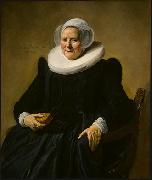 |
Frans Hals
|
|
1580-1666
Frans Hals Galleries
In the field of group portraiture his work is equalled only by that of Rembrandt. Hals's portraits, both individual and group, have an immediacy and brilliance that bring his sitters to life in a way previously unknown in the Netherlands. This effect, achieved by strong Baroque designs and the innovative use of loose brushstrokes to depict light on form, was not to the taste of critics in the 18th century and the early 19th, when his work was characterized as lazy and unfinished. However, with the rise of Realism and, later, Impressionism, Hals was hailed as a modern painter before his time. Since then his works have always been popular. |
 |
Frank Holl
|
|
1845-1888
Painter and illustrator. He received his first art instruction from his father, Francis Holl. At the age of 15 he entered the Royal Academy Schools, where in 1862 he was awarded a silver medal for drawing and in 1863 the gold medal for a religious subject, Abraham about to Sacrifice Isaac (untraced). In 1864 he exhibited two paintings at the Royal Academy, |
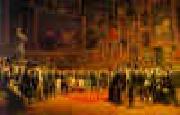 |
Francois-Joseph Heim
|
|
1787-1865
French Francois-Joseph Heim Gallery
He was born at Belfort. He early distinguished himself at the Ecole Centrale of Strassburg, and in 1803 entered the studio of Vincent at Paris. In 1807 he obtained the first prize, and in 1812 his picture of The Return of Jacob (Musee de Bordeaux) won for him a gold medal of the first class, which he again obtained in 1817, when he exhibited, together with other works, a St John-bought by Vivant Denon.
In 1819 the Resurrection of Lazarus (Cathedral Autun), the Martyrdom of St Cyr (St Gervais), and two scenes from the life of Vespasian (ordered by the king) attracted attention. In 1823 the Re-erection of the Royal Tombs at St Denis, the Martyrdom of St Laurence (Nôtre Dame) and several full-length portraits increased the painter popularity; and in 1824, when he exhibited his great canvas, the Massacre of the Jews (Louvre), Heim was rewarded with the Legion of Honour.
In 1827 appeared the King giving away Prizes at the Salon of 1824 (Louvre-engraved by Jazet) the picture by which Heim is best known and Saint Hyacinthe. Heim was now commissioned to decorate the Gallery Charles X (Louvre). Though ridiculed by the romantists, Heim succeeded Regnault at the Institute in 1834, shortly after which he commenced a series of drawings of the celebrities of his day, which are of much interest.
His decorations of the Conference room of the Chamber of Deputies were completed in 1844; and in 1847 his works at the Salon Champ de Mai and Reading a Play at the Theatre Francais were the signal for violent criticisms. Yet something like a turn of opinion in his favour took place at the exhibition of 1851; his powers as draughtsman and the occasional merits of his composition were recognized, and toleration extended even to his colour.
Heim was awarded the great gold medal, and in 1855-having sent to the Salon no less than sixteen portraits, amongst which may be cited those of Cuvier, Geoffroy de St Hilaire, and Madame Hersent he was made officer of the legion of honour. In 1859 he again exhibited a curious collection of portraits, sixty-four members of the Institute arranged in groups of four.
Besides the paintings already mentioned, there is to be seen in Notre Dame de Lorette (Paris) a work executed on the spot; and the museum of Strassburg contains an excellent example of his easel pictures, the subject of which is a Shepherd Drinking from a Spring. |
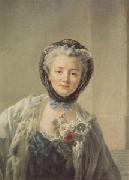 |
Francois-Hubert Drouais
|
|
Paris 1727-Rome 1775
was a French painter and Jean-Germain Drouais's father. He specialized in portraits, some of which include Louis XV's last two mistresses, Madame de Pompadour and Madame du Barry respectively. He even painted the young Marie Antoinette. |
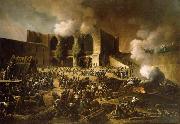 |
Francois Joseph Heim
|
|
(16 December 1787 - 29 September 1865) was a French painter.
He was born at Belfort. He early distinguished himself at the École Centrale of Strassburg, and in 1803 entered the studio of Vincent at Paris. In 1807 he obtained the first prize, and in 1812 his picture of "The Return of Jacob" (Musee de Bordeaux) won for him a gold medal of the first class, which he again obtained in 1817, when he exhibited, together with other works, a St John--bought by Vivant Denon.
In 1819 the "Resurrection of Lazarus" (Cathedral Autun), the "Martyrdom of St Cyr" (St Gervais), and two scenes from the life of Vespasian (ordered by the king) attracted attention. In 1823 the "Re-erection of the Royal Tombs at St Denis," the "Martyrdom of St Laurence" (Nôtre Dame) and several full-length portraits increased the painter's popularity; and in 1824, when he exhibited his great canvas, the "Massacre of the Jews" (Louvre), Heim was rewarded with the Legion of Honour.
In 1827 appeared the "King giving away Prizes at the Salon of 1824" (Louvre--engraved by Jazet) the picture by which Heim is best known and "Saint Hyacinthe." Heim was now commissioned to decorate the Gallery Charles X (Louvre). Though ridiculed by the romantists, Heim succeeded Regnault at the Institute in 1834, shortly after which he commenced a series of drawings of the celebrities of his day, which are of much interest.
His decorations of the Conference room of the Chamber of Deputies were completed in 1844; and in 1847 his works at the Salon "Champ de Mai" and "Reading a Play at the Theâtre Français" were the signal for violent criticisms. Yet something like a turn of opinion in his favour took place at the exhibition of 1851; his powers as draughtsman and the occasional merits of his composition were recognized, and toleration extended even to his colour.
Heim was awarded the great gold medal, and in 1855--having sent to the Salon no less than sixteen portraits, amongst which may be cited those of Cuvier, Geoffroy de St Hilaire, and Madame Hersent he was made officer of the legion of honour. In 1859 he again exhibited a curious collection of portraits, sixty-four members of the Institute arranged in groups of four.
Besides the paintings already mentioned, there is to be seen in Nôtre Dame de Lorette (Paris) a work executed on the spot; and the museum of Strassburg contains an excellent example of his easel pictures, the subject of which is a Shepherd Drinking from a Spring.
cjr |
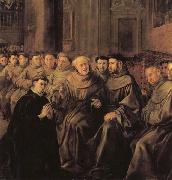 |
Francisco de herrera the elder
|
|
Spanish Baroque Era Painter, ca.1590-1656
Spanish painter. His early works are in the Mannerist style. Under the influence of Francisco Zurbaren, he developed the naturalistic style seen in his four scenes from the life of St. Bonaventure (1627). About 1650 he moved to Madrid. His last documented work, a painting of St. Joseph (1648) influenced by Anthony Van Dyck, features elongated forms and elaborate draperies. He achieved considerable fame in Sevilla, where Diego Velezquez was briefly his pupil. His work marked the transition from Mannerism to the Baroque. His son, Francisco Herrera the Younger |
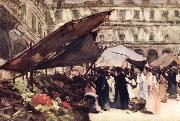 |
Francis Hopkinson Smith
|
|
Engineer, artist, illustrator, and short story writer
American , 1838-1915
United States author, artist and engineer, was born in Baltimore, Maryland, a descendant of Francis Hopkinson, one of the signers of the Declaration of Independence. Smith became a contractor in New York City and did much work for the federal government, including the stone ice-breaker at Bridgeport, Connecticut, the jetties at the mouth of the Connecticut River, the foundation for the Bartholdi Statue of Liberty in New York Harbor, the Race Rock Lighthouse (southwest of Fishers Island, New York) and many life-saving stations. His vacations were spent sketching in the White Mountains, in Cuba and in Mexico. |
 |
Francis Holman
|
|
(1729-1784) was a British maritime painter, little recognised during his own lifetime, but whose paintings are now sought aftereHe is also notable as the teacher of Thomas Luny.
He was born in Ramsgate and baptized on 14 November 1729 at St Laurence-in-Thanet, Ramsgate.[1] He was the eldest son and second of six children of Francis Holman (1696-1739), and his wife, Anne Long (1707-1757). His father was a master mariner, and his grandfather a Ramsgate cooper. His younger brother, Captain John Holman (1733-1816), maintained the family shipping business and remained close to Francis throughout his life. Young Francis would certainly have been immersed in the maritime world during his up-bringing; the legacy of this early knowledge is a wealth of detail and accuracy in his later work.
The moonlight Battle of Cape St Vincent, 16 January 1780 by Francis Holman, painted 1780
A sixth-rate British man of war off Dover, by Francis Holman, 1777
A small shipyard on the Thames, by Francis Holman, between 1760 and 1784Francis Holman lived in at least five addresses in Wapping on the Thames in London. He married, firstly, Elizabeth, and they produced 3 sons; John (b. 1757), and two more sons, both named Francis, who died in infancy. Elizabeth's death is unrecorded, but on 7 May 1781 he married, secondly, Jane Maxted (c.1736-1790). He was apparently childless when he wrote his will in 1783.
|
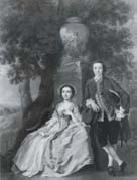 |
Francis Hayman
|
|
English Painter, 1708-1776,English painter and illustrator. He was in London at the age of 10, and from 1718 until c. 1725 he was apprenticed to Robert Brown (d 1753), a decorative painter. From 1732 Hayman was employed as a scene painter at Goodman's Fields Theatre, where he painted allegorical works such as The King Attended by Peace, with Liberty and Justice Trampling on Tyranny and Oppression on the pit ceiling (destr.). He moved to Drury Lane Theatre in 1736, shortly before the Licensing Act closed Goodman's Fields. At Drury Lane he painted scenery for Thomas Arne's masque The Fall of Phaeton (1736) and was praised for his naturalistic landscapes. From the late 1730s he began accepting commissions for portraits and conversation pieces. His success in the field of portraiture rested on the dearth of good portrait painters in England at the time and his exploitation of a growing middle-class clientele. Hayman painted portraits of doctors, literary men and actors. |
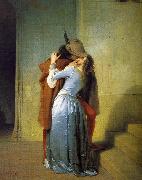 |
Francesco Hayez
|
|
1791-1882
Italian
Francesco Hayez Galleries
Hayez came from a relatively poor family from Venice. His father was of French origin while his mother, Chiara Torcella, was from Murano. The child Francesco, youngest of five sons, was brought up by his mother sister, who had married Giovanni Binasco, a well-off shipowner and collector of art. From childhood he showed a predisposition for drawing, so his uncle apprenticed him to an art restorer. Later he became a student of the painter Francisco Magiotto with whom he continued his studies for three years. He was admitted to the painting course of the New Academy of Fine Arts in 1806, where he studied under Teodoro Matteini. In 1809 he won a competition from the Academy of Venice for one year of study at the Accademia di San Luca in Rome. He remained in Rome until 1814, then moved to Naples where he was commissioned by Joachim Murat to paint a major work depicting Ulysses at the court of Alcinous. In the mid 1830s he attended the Salotto Maffei salon in Milan, hosted by Clara Maffei (whose portrait Hayez painted for her husband), and he was still in Milan in 1850 when he was appointed director of the Academy of Brera there.
Assessment of the career of Hayez is complicated by the fact that he often did not sign or date his works. Often the date indicated from the evidence is that at which the work was acquired or sold, not of its creation. Moreover he often painted the same compositions several times with minimal variations, or even with no variation. His early works show the influence of Ingres and the Nazarene movement. His later work participates in the Classical revival. |
 |
Fitz Henry Lane
|
|
(December 19, 1804 - August 14, 1865) was an American painter and printmaker of a style that would later be called Luminism, for its use of pervasive light.
Fitz Henry Lane was born on December 19, 1804, in Gloucester, Massachusetts. Lane was christened Nathaniel Rogers Lane on March 17, 1805, and would remain known as such until he was 27. It was not until March 13, 1832 that the state of Massachusetts would officially grant Lanees own formal request (made in a letter dated December 26, 1831) to change his name from Nathaniel Rogers to Fitz Henry Lane. As with practically all aspects of Lanees life, the subject of his name is one surrounded by much confusioneit was not until 2005 that historians discovered that they had been wrongly referring to the artist as Fitz Hugh, as opposed to his chosen Fitz Henry, and the reasons behind Lanees decision to change his name, and for choosing the name he did, are still very unclear.
|
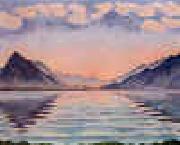 |
Ferdinand Hodler
|
|
1853-1918
Swiss Ferdinand Hodler Galleries
Hodler was born in Berne and grew up in poverty. His father, Jean Hodler, made a meager living as a carpenter; his mother, Marguerite (n??e Neukomm), was from a peasant family. By the time Hodler was eight years old, he had lost his father and two younger brothers to tuberculosis. His mother remarried to a decorative painter, but in 1867 she too died of tuberculosis. Before he was ten, Hodler received training in decorative painting from his stepfather, and was subsequently sent to Thun to apprentice with a local painter, Ferdinand Sommer. Hodler's earliest works were conventional landscapes, which he sold in shops and to tourists. In 1871, at the age of 18, he traveled on foot to Geneva to start a career as a painter.
The works of Hodler's early maturity consisted of landscapes, figure compositions and portraits, treated with a vigorous realism. He made a trip to Basel in 1875, where he studied the paintings of Hans Holbein??especially Dead Christ in the Tomb, which influenced Hodler's many treatments of the theme of death. In the last decade of the 19th century his work evolved to combine influences from several genres including symbolism and art nouveau. He developed a style which he called Parallelism, characterized by groupings of figures symmetrically arranged in poses suggesting ritual or dance.
In 1884 Hodler met Augustine Dupin (1852?C1909), who became his companion and model for the next several years. Their son, Hector Hodler, was born in 1887. In 1889 Hodler married Bertha Stucki; they were divorced in 1891.
Hodler's work in his final phase took on an expressionist aspect with strongly coloured and geometrical figures. Landscapes were pared down to essentials, sometimes consisting of a jagged wedge of land between water and sky. However, the most famous of Hodler's paintings portray scenes in which characters are engaged in everyday activities, such as the famous woodcutter (Der Holzfaller, Mus??e d'Orsay, Paris). This picture went on to appear on the back of the 50 Swiss Franc bank note issued by the Swiss National Bank.
In 1898, Hodler married Berthe Jacques. In 1914 he condemned the German atrocities conducted using artillery at Rheims. In retaliation for this, German art museums excluded Hodler's work.
In 1908 he met Valentine Gode-Darel, who became his mistress. She was diagnosed with cancer in 1913, and the many hours Hodler spent by her bedside resulted in a remarkable series of paintings documenting her disintegration. Her death in January 1915 affected Hodler greatly. He occupied himself with work; a series of about 20 introspective self-portraits date from 1916. By late 1917 his declining health led him to thoughts of suicide. He died on May 19, 1918 in Geneva leaving behind a number of unfinished works portraying the city. |
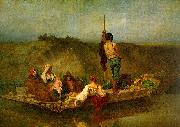 |
Ernest Hebert
|
|
1817-1908
French
Ernest Hebert Gallery
He was born in Grenoble and died in La Tronche. His painting Mal aria was exhibited in the Salon of 1850-1851, and now hangs in the Musee d Orsay, Paris. Painted in a Romantic style, it depicts a family of Italian peasants escaping an epidemic by raft, a scene inspired by events Hebert had witnessed while in Italy.
His student Paul Trouillebert was an important artist of the Barbizon School.
The artist house is preserved in the Musee Hebert in the VIe arrondissement of Paris. There is another museum near Grenoble. |
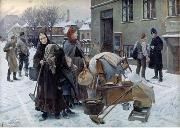 |
Erik Henningsen
|
|
(29 August 1855 - 28 November 1930) was a Danish painter and illustrator. He is best known for his Social Realist paintings of poor and exposed groups in the 1880s and 1890s. He was the younger brother of Frants Henningsen who was also a painter.
Erik Henningsen was born on 29 August 1855 in Copenhagen to Frants Ludvig Henningsen (1820-1869), a grocer, and Hilda Charlotte Christine ne Schou (1824-1880). He showed an early artistic talent and was articled to decorative painter A. Hellesen. He also took drawing lessons privately with C. V. Nielsen and was admitted to the Royal Danish Academy of Fine Arts in 1873. He graduated in 1877 and won several awards and distinctions, including the Academy's Annual Medal in 1887 and 1890, the Ancher Prize in 1889. |
 |
Emile Jean Horace Vernet
|
|
French, 1789-1863,Painter, son of Carle Vernet. He was born in his father's lodgings at the Palais du Louvre, where his grandfather Joseph Vernet also lived; his maternal grandfather was Jean-Michel Moreau. To these antecedents and influences are ascribed the supreme ease of his public career, his almost incredible facility and his fecundity. His early training in his father's studio was supplemented by formal academic training with Francois-Andre Vincent until 1810, when he competed unsuccessfully for the Prix de Rome. He first exhibited at the Salon in 1812. In 1814 Vernet received the Legion d'honneur for the part he played in the defence of Paris, which he commemorated in the Clichy Gate: The Defence of Paris, 30 March 1814. |
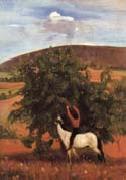 |
Egedius, Halfdan
|
|
1877-1899,Norwegian painter and illustrator. His artistic education began at the age of nine, when he enrolled at the school of art of Knud Bergslien (1827-1908) in Kristiania, where he was a pupil from 1886 to 1889. Even from this early period his painted studies and drawings, for instance of his sister Signe and brother Carl (both 1887; Oslo, N.G.), reveal striking maturity. In 1891 he was a pupil of Erik Werenskiold and from 1891 to 1892 he studied at the Arts and Crafts School in Kristiania. Egedius discovered his strongest impetus and greatest inspiration, however, on his first visit to Telemark in south-west Norway in summer 1892. The artist Torleif Stadskleiv (1865-1946), whom he met there and who became his closest friend, endeared the region to Egedius with stories of its traditions and people. In 1894 Egedius studied for a short period under Harriet Backer, and he made his d?but at the Kristiania Autumn Exhibition in 1894 with the painting Saturday Evening (Oslo, N.G.), painted in Telemark the previous year, which won high praise. In this landscape the atmosphere of the summer night is rendered with a lyrical use of colour and soft brushstrokes. Egedius spent the summer of 1894 in the inspiring and instructive company of a group of artists at V?g? in the Gudbrands Valley in north-west Norway, but for the summer of 1895 he was again in Telemark. Since his previous stay there he had matured artistically and his work now revealed a new confidence and boldness. The most notable paintings from 1895 are 'Juvrestolen' in Telemark, The Dreamer, Girls Dancing and the magnificent portrait of Mari Clasen (all Oslo, N.G.). He also began work on Music and Dance (Oslo, N.G., see fig.), which he continued the following year. |
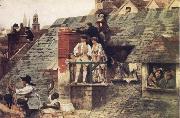 |
Edwin Howland Blashfield
|
|
mural painter and mosaic designer.
American ,1848-1936
American painter. He began to study art seriously in 1867 in Paris under L?on Bonnat, with whom he remained (except between 1870 and 1874) until 1880. Blashfield's mural style was significantly influenced by Pierre Puvis de Chavannes, Jean-Paul Laurens and Paul Baudry, whose decorations he had studied in the Panth?on while in Paris. He made a trip in 1887 to England, where he became briefly associated with the Anglo-American artists' colony in Broadway, Glos, which included Edwin Austin Abbey, John Singer Sargent, Lawrence Alma-Tadema and Frederic Leighton. |
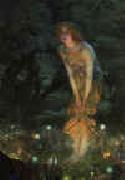 |
Edward Robert Hughes
|
|
British
1851-1917
Edward Robert Hughes (1851-1917) is a well known English painter who worked in a style influenced by Pre-Raphaelitism and Aestheticism. Some of his best known works are Midsummer Eve and Night With Her Train of Stars. Hughes was the nephew of Arthur Hughes. He often used watercolour/gouache. He was elected ARWS in 1891 and chose as his diploma work for election to full membership a mystical piece inspired by a verse by Christina Rossetti's "Amor Mundi". Technically Hughes experimented with ambitious techniques. He was a perfectionist who did numerous studies which in their own right turned out to be good enough for exhibition
He was also an assistant to the elderly William Holman Hunt. He helped the increasingly infirm Hunt with the version of The Light of the World now in St. Paul's Cathedral and with The Lady of Shalott. He died on April 23 1914 at his cottage in St. Albans, Hertfordshire.
|
 |
Edward lamson Henry
|
|
A popular and prolific genre artists at the end of the 19th century
American , 181-1919
American painter. He received his first art instruction in New York from Walter M. Oddie (1808-65), followed by two years at the Pennsylvania Academy of the Fine Arts, Philadelphia (1858-60). After this he left for a two-year stay abroad, studying with Paul Weber (1823-1916), Charles Gleyre and Courbet. In 1864 he served as a captain's clerk on a boat taking supplies to the Union army. Two notable pictures that emerged from this experience were City Point, Virginia, Headquarters of General Grant (1865-72; Andover, MA, Phillips Acad., Addison Gal. A.) and Westover Mansion (1869; Washington, DC, Corcoran Gal. A.). He soon won recognition and was elected to the National Academy by 1869. Many of his paintings were sold before exhibition, |
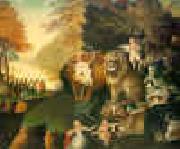 |
Edward Hicks
|
|
1780-1849
Edward Hicks (April 14, 1780 ?C August 23, 1849) was an American Folk painter, a distinguished minister of the Society of Friends, and he also became a Quaker icon because of his paintings.
Edward Hicks was born in his grandfather's mansion at Langhorne, in Bucks County, Pennsylvania. He was born into a life of luxury, and his parents were both Anglican. After his mother passed away when he was eighteen months old, Matron Elizabeth Twining - a close friend of his mother's- raised him as one of her own. She also taught him the Quaker beliefs. This had a great effect on the rest of his life.
At the age of thirteen he was an apprentice for coach makers William and Henry Tomlison. He stayed with them for seven years. His living situation inspired him to desire a much better way of life for himself. He wanted a simple, well respected life and to be able to earn his own wages. He wanted to be able to make choices for himself, in all that he did. It was then that he knew that something amusing and entertaining such as a career in art could satisfy his goals. He spent three years contemplating what his life meant to him, and grew a strong passion for art. His religious commitments affected his thoughts on living and art in many ways. In 1803, he married a Quaker woman named Sarah Worstall. |
|

